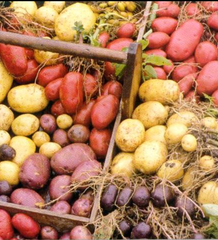
We got really hot really early. Spring caught us by surprise. I never thought we would want rain again but it turned off dry. I heard someone say that the only time farmers aren't hoping for rain was when it was raining. That certainly wasn't true this past winter and we still have remnants from the big storm in October and many rainy days since. The wet fields delayed getting ready to plant the spring crops. Now we're playing catch up but hopefully everything will be planted on time.
Spring brings the babies including the chicks, calves, and piglets.
We have 200 chicks out now with the Rent A Chick program and 100 more going out in April. (click here if you want to sign up http://legarefarms.com/pages/rent-a-chick); Chick pick up days are always fun because the children are so excited about the chicks. It's fun to watch them and the best part is the names that they give the chicks.
We've been doing a lot of Chicken and Egg field trips.
This field trip not only teaches the children about chickens but includes an egg hunt. We also do a Springtime on the Farm field trip. This covers everything that happens on the farm in the spring including the babies and planting. Needless to say, spring is a busy time on the farm.
Linda talks about potatoes in the following few paragraphs but I want to remind you about planting your own garden.
It's way too late for planting potatoes and really too late for onions. You still have time to get the tomatoes, peppers, eggplant, okra, butter beans, and peas planted. We plant tomatoes, peppers, and eggplant from starter plants but plant most everything else from seed directly into the field. We have some extra plants available to purchase if you need some. They are in 4 packs for $2 each. We have tomatoes, several kinds of peppers, eggplant, zucchini, squash, and cucumbers.
Linda contributed the following.
This month is time to plant our gardens so I thought it would be a good time to talk about some of the more commonly grown vegetables.
The cultivation of potatoes goes back to approximately 8000 BC. They were first grown in Peru. In the late 1500s they spread from there to Spain and the British Isles. From there they spread to all of Europe and the rest of the world.
One of the earliest planted vegetables in the low country is the potato. Here in the Lowcountry potatoes are generally planted in mid February but will grow at other times of the year. The seed potatoes are cut up into several parts with each one having an "eye". They can be placed in a hole in the ground then covered with soil. Or they can also be covered in straw or mulch. After several months, when the potato plants start to go to seed (put on flowers), The potatoes are ready to be dug.
As children, not only did we help with the planting of the garden but with the harvesting. Each year after we dug the potatoes we spread them out on old screen doors or window screens and placed the screens in the rafters of the tractor shed to cure. We would usually have potatoes to eat for a large part of the year from this crop.
There are hundreds of different varieties of potatoes. I'm always intrigued by the different ones I see in seed catalogs and in the grocery store. Purple,blue,Yukon Gold, they all look so cool however there's not really much difference in taste. Just regular white or red ones seem to taste the best.
Potatoes are one of my favorite foods. I think I could eat them three meals a day seven days a week.They are incredibly versatile and can be cooked dozens of different ways. However I think one of the best ways is to boil up a pot of new potatoes freshly dug up out of the ground. Serve them with a little butter and they are good to go. Boiled new potatoes cooked with fresh snap beans and a little bacon grease was one of our grandmother's favorite comfort foods in the spring.
Johns Island was once world famous for its potatoes but I will tell you more about that in another issue.
Calendar
April 8th and 9th Rent A Chick pickup
April 10th Finger Lickin Chicken Wing Fling Thing
May 12th Wine Tasting and Food Pairing at Pickled Palate
May 15th Big Red Barn Festival
June 13-17 Summer Camp 6-8 year olds
June 20-24 Summer Camp 9-11 year olds
July 11-15 Summer Camp 6-8 year olds
July 18-22 Summer Camp 9-11 year olds
Feature of the Month
Community Supported Agriculture (CSA) vegetable program will begin deliveries the last week of April. You can still join to receive vegetables every week for 15 weeks--9 in the spring/summer and 6 weeks in the fall. You can join at this link http://legarefarms.com/pages/csa-program
Special of the Month
Beef and pork marrow bones. We have packs of marrow bones available for you to make your own broth. They come in pack of about 2 lbs. each and are on sale for $2.00/lb.
Here's how to make a good beef (or pork) broth:
Simply place a big bunch of bones in a crock-pot or a big stockpot, cover them with cold water and set the temperature on low heat so it doesn’t do much more than simmer.
Add 2 tablespoons of apple cider vinegar to the cold water to help draw the nutrients from the bones.
You can roast your beef bones beforehand for 25-30 minutes at about 375oF (190oC) and then use them to make your stock. This technique makes a much darker stock with a roasted flavor.
You can easily mix things up and use bones from different animals all in the same pot.
A lot of people will tell you to skim the froth that forms at the surface of a stock as it cooks, but it’s harmless. Skimming the foam or “scum” as it’s sometimes called, is simply a matter of culinary preference and is done to create a clear broth or stock. If you don’t mind the way it looks, leave it and all the goodness that it might contain.
Allow a minimum of 6 hours for beef bones maybe less for pork. You can easily let it go for much longer if you want to extract more taste and nutrients from the bones, as much as 48 hours. Just make sure you add water as it evaporates and continue drawing out the concentration.
You can add seasoning to the stock also. Fresh herbs or dried herbs make nice additions. Vegetables can be added also for flavoring. Don't add salt. It can be added later when making soup or stews with the stock.
Recipe of the Month
Since I've already shared the bone broth recipe, I thought I'd give you a really easy one this month.
Mexican Beef Hash
1 Cup chopped onion
1 Cup chopped green pepper
1 lb. ground beef Legare Farms' of coarse
3 to 4 teaspoons chili powder 2 teaspoons salt
¼ teaspoon pepper
1 cup uncooked rice
2 (1lb.) cans tomatoes (4Cups fresh)
Saute onion and green peppers with ground beef until beef is browned. Add remaining ingredients, except tomatoes and mix well. Line 2 (1 ½ quart) casseroles with aluminum foil. Divide mixture evenly between the 2 casseroles. Pour 1 can tomatoes over each casserole and mix lightly to blend. Cover and bake in moderate oven (350 degrees) for 1 hour and 20 minutes. You may freeze 1 of the casseroles to serve later. Cook for 20 minutes then remove from oven, let cool to room temperature, place in freezer. When completely frozen remove aluminum foil and cover with Saran Wrap and return to freezer. Recommended storage time 3 to 6 months. To serve remove from freezer, remove Saran Wrap and cook at 350 degrees for 1 hour.
To see our other great recipes, click here.
The next few months are going to be really busy at the farm. I hope you will try and come out for one of our events. We try to be open every Saturday 9 till noon so come by and visit.
If you have any questions or suggestions, call or email us,
Helen Legare-Floyd
